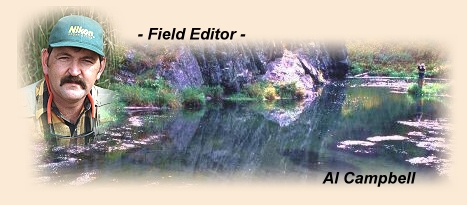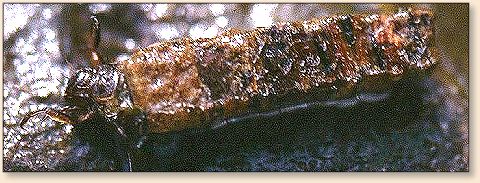|
I went looking for caddisflies this week, but couldn't
find any. Every year for the last 10 years, I have
been able to observe caddisflies by the second week
in May on the creek that runs through town near my
house, but not this year. Where did they go?
Last summer we had a severe drought and many streams
dried up completely. That has to be hard on the
uatic insect reproductive rate. Maybe that's the
reason I'm not seeing any caddisflies? But wait,
this particular stream had water running through
it all year and wasn't one of the streams that dried
up. That can't be the answer.
Maybe pollution is the culprit. If you listen to
several of the more radical factions of the
environmental movement, every stream in this state
is at serious risk of an immediate death due to
pollution. Maybe we polluted them to death? Well,
other insects and fish are doing fine in the stream,
so that isn't the case.
It has been unseasonably cool and wetter than normal
in the last month. Maybe the cold weather has had a
slowing effect on the hatch. Aquatic insects need a
specific combination of time in the water, sun angle
and thermal days to reach the stage where they are
developed enough to pupate and emerge as adults.
Maybe it has just been too cold this year for the
insects to be on schedule. That's a possibility,
but similar weather patterns have been in place
here in the last ten years, and they didn't slow
the hatch this way.
Maybe there is an exotic disease that killed off only
the caddisflies? Other insects like midges and baetis
mayflies are hatching, so the disease has to be specific
to caddisflies if this theory is to work. How would
anyone know for sure? Do we need a special team of
biologists to study this? How could any layman know
for sure?
Maybe the caddisflies are protesting the idea that midges,
some mayflies and some stoneflies always get to hatch
earlier in the season than they do. Every year it's
the same old thing. The other insects hatch earlier
and steal the limelight, so maybe caddisflies have
had enough and just wanted to show the rest of the
world that they deserve some respect too. I can
imagine thousands of cased caddis larvae holding
tiny protest signs saying they won't hatch until
they get the respect they deserve. Of course, I
can imagine a lot of things, and some are a little
more realistic than others.
How would you go about finding the answer? Is there
a Dr. Phil of caddisflies that we could ask? Could
we coerce a few mayflies to rat on their caddisfly
neighbors? You don't suppose we could get a straight
answer from the midges or maybe the stoneflies, do you?
There has to be a way to determine what is going on
in the caddisfly world. What would you do to get an
answer?
I decided to look for myself. There on the stream bottom
I found some rocks and turned them over to see if anything
was hiding under them. Sure enough, there under the rocks
were hundreds of tiny organic homes, each one holding a
caddisfly larva. The caddisflies are there, but they
haven't found the ideal environment to hatch from. No
protests, no pollutants, just a bit too cold to hatch
just yet.
I'm guessing a week from now we'll see a bunch of adult
caddisflies. Whew, I didn't tie all those elk hair
caddis patterns in vain.
~ AC
|





